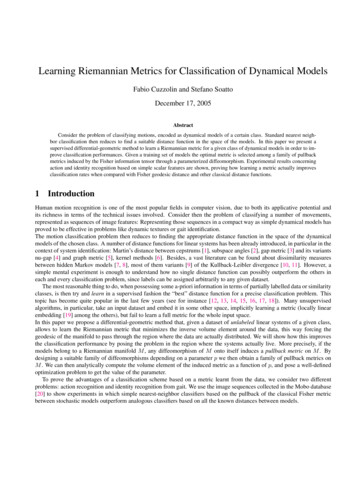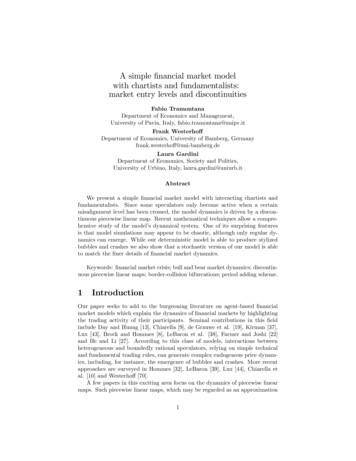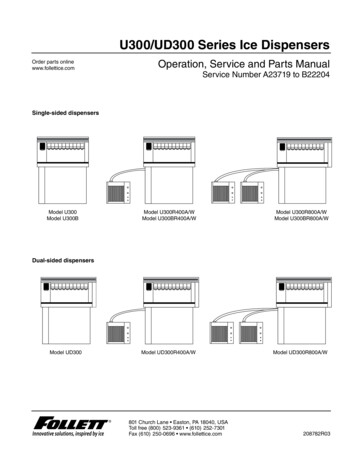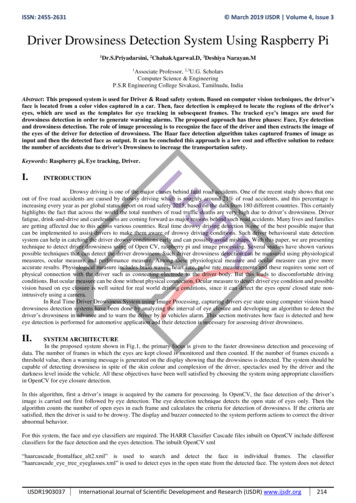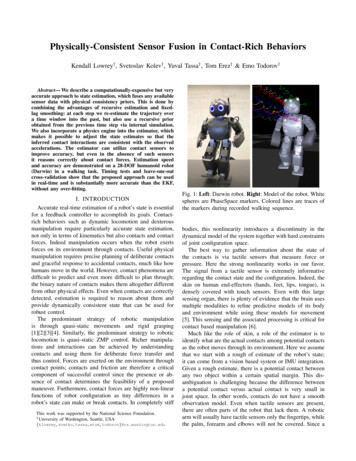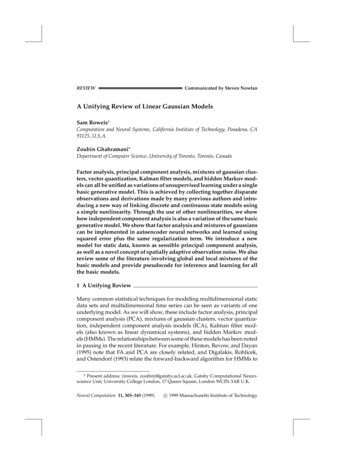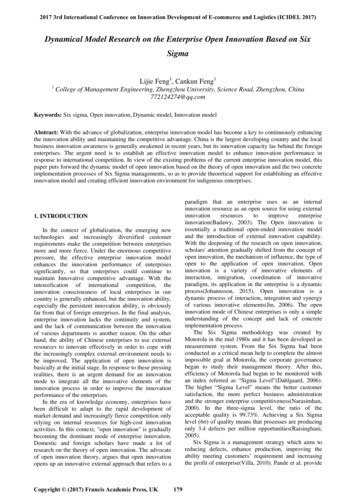
Transcription
2017 3rd International Conference on Innovation Development of E-commerce and Logistics (ICIDEL 2017)Dynamical Model Research on the Enterprise Open Innovation Based on SixSigmaLijie Feng1, Cankun Feng11College of Management Engineering, Zhengzhou University, Science Road, Zhengzhou, China772124274@qq.comKeywords: Six sigma, Open innovation, Dynamic model, Innovation modelAbstract: With the advance of globalization, enterprise innovation model has become a key to continuously enhancingthe innovation ability and maintaining the competitive advantage. China is the largest developing country and the localbusiness innovation awareness is generally awakened in recent years, but its innovation capacity las behind the foreignenterprises. The urgent need is to establish an effective innovation model to enhance innovation performance inresponse to international competition. In view of the existing problems of the current enterprise innovation model, thispaper puts forward the dynamic model of open innovation based on the theory of open innovation and the two concreteimplementation processes of Six Sigma managements, so as to provide theoretical support for establishing an effectiveinnovation model and creating efficient innovation environment for indigenous enterprises.paradigm that an enterprise uses as an internalinnovation resource as an open source for using vation(Badawy, 2003). The Open innovation isessentially a traditional open-ended innovation modeland the introduction of external innovation capability.With the deepening of the research on open innovation,scholars' attention gradually shifted from the concept ofopen innovation, the mechanism of influence, the type ofopen to the application of open innovation. Openinnovation is a variety of innovative elements ofinteraction, integration, coordination of innovativeparadigm, its application in the enterprise is a dynamicprocess(Johannsson, 2015). Open innovation is adynamic process of interaction, integration and synergyof various innovative elements(Jin, 2006). The openinnovation mode of Chinese enterprises is only a simpleunderstanding of the concept and lack of concreteimplementation process.The Six Sigma methodology was created byMotorola in the mid 1980s and it has been developed asmeasurement system. From the Six Sigma had beenconducted as a critical mean help to complete the almostimpossible goal at Motorola, the corporate governancebegan to study their management theory. After this,efficiency of Motorola had begun to be monitored withan index referred as “Sigma Level”(Dahlgaard, 2006).The higher “Sigma Level” means the better customersatisfaction, the more perfect business administrationand the stronger enterprise competitiveness(Narasimhan,2000). In the three-sigma level, the ratio of theacceptable quality is 99.73%. Achieving a Six Sigmalevel (6σ) of quality means that processes are producingonly 3.4 defects per million opportunities(Raisinghani,2005).Six Sigma is a management strategy which aims toreducing defects, enhance production, improving theability meeting customers’ requirement and increasingthe profit of enterprise(Villa, 2010). Pande et al. provide1. INTRODUCTIONIn the context of globalization, the emerging newtechnologies and increasingly diversified customerrequirements make the competition between enterprisesmore and more fierce. Under the enormous competitivepressure, the effective enterprise innovation modelenhances the innovation performance of enterprisessignificantly, so that enterprises could continue tomaintain Innovative competitive advantage. With theintensification of international competition, theinnovation consciousness of local enterprises in ourcountry is generally enhanced, but the innovation ability,especially the persistent innovation ability, is obviouslyfar from that of foreign enterprises. In the final analysis,enterprise innovation lacks the continuity and system,and the lack of communication between the innovationof various departments is another reason. On the otherhand, the ability of Chinese enterprises to use externalresources to innovate effectively in order to cope withthe increasingly complex external environment needs tobe improved. The application of open innovation isbasically at the initial stage. In response to these pressingrealities, there is an urgent demand for an innovationmode to integrate all the innovative elements of theinnovation process in order to improve the innovationperformance of the enterprises.In the era of knowledge economy, enterprises havebeen difficult to adapt to the rapid development ofmarket demand and increasingly fierce competition onlyrelying on internal resources for high-cost innovationactivities. In this context, "open innovation" is graduallybecoming the dominant mode of enterprise innovation.Domestic and foreign scholars have made a lot ofresearch on the theory of open innovation. The advocateof open innovation theory, argues that open innovationopens up an innovative external approach that refers to aCopyright (2017) Francis Academic Press, UK179
a representative definition of Six Sigma as: Acomprehensive and flexible system for achieving,sustaining, and maximizing business success. Six Sigmais uniquely driven by close understanding of customerneeds, disciplined use of facts, data, and statisticalanalysis, and diligent attention to managing, improving,and reinventing business processes(Pande, 2007). SixSigma is a project-oriented approach which increases theeconomic profit through quality improvement(Antony,2002). And Six Sigma project is conducted by an expertgroup typically referred to Six Sigma managementcommittees, champions, master black belts, black belts,and green belts(Sin, 2015). That’s a learning team. In theprocess of development it formed Six Sigmaimprovements and design for Six Sigma two importantmethods(Fukun, 2016).In this paper, the Six Sigma specific implementationprocesses are applied to the innovation process of eachdepartment. Then the dynamic mode of enterprise openinnovation based on Six Sigma is putting forward, whichmakes technological innovation, management innovationand service innovation to promote the benign interactivebenefits and provides a systematic approach for thewhole process of continuous innovation. How does theSix Sigma management approaches combine with theopen innovation mode? What are the characteristics ofthis innovative mode? This article will be furtherelaborated on these issues.Market Operation reflection in that market operationdepartment could take a feedback to Product R&Ddepartment including customer feedback, the marketpotential of product, distribution capabilities, marketservice power and so on. It’s a vital reference to thechoice and direction of Product R&D. Furthermore, theinnovation characteristics of new product are the mostimportant element deciding the market operating strategy.The advantage and the disadvantage of product is theelement that must be considered by Market Operatingdepartment. Therefore, The Synergy effect betweenProduct R&D and Market Operation promote andinfluence each other through the exchange ofinformation.2.2 Synergy Effect Between Product R&D andProduction controlThe synergy effect between Product R&D andProduction Control reflection in that Product R&Ddepartment provide the latest product model toProduction Control department for directing production.Innovative product is an important element that affectsproduction plan and production organization ofProduction Control department. Besides, ProductionControl department influences the choice and directionof Product R&D through the feedback informationincluding production qualified rate, enterprise productioncapacity. Consequently, the Synergy effect betweenProduct R&D and Production Control is a mutuallybeneficial effect through the optimal choice ofProduction and R&D.2. THE ENTERPRISE OPEN INNOVATIONSUPPORT SYSTEM2.3 Synergy Effect Between Market Operation andProduction controlThe enterprise innovation value chain is a parentsystem composed of various subsystems and the mostsignificant three subsystems are Product R&D,Production Control and Market Operation. Product R&Dis to explore the potential demand of customers, usingthe knowledge of science and technology (such asliterature, patent, knack) for innovation, which is anactivity achieving innovation through the function,structure or product improving. Production Control is thegeneral term composed of various management workwhich are aimed to establish and operate enterprisemanufacture system. Marketing Operation is the activity,set of institutions, and processes for creating,communicating, delivering, and exchanging offeringsthat have value of customers, clients, partners, andsociety at large. The three subsystems are closely linkedand communicate with each other by product flow,information flow and capital flow. Based on this, theyare mutually beneficial and the improvement in anysubsystems could promote total performance.The synergy effect between Market Operation andProduction control reflection in that Market Operationtake a large extent affect to the production plan, asdifferent product sales determines the differentproduction plan. On the other hand, Production Controldepartment performance determines Market Operationstrategy as only special strategy could obtain the bestperformance according to different production capacityand quality. Thus, the synergy effect between MarketOperation and Production Control interact through theproduct flow in the system.The synergies between the two companies have asignificant impact on the innovation ability of enterprisesbased on the relationship between product R&D,production control and market operation. Threedepartments at the same time open innovation, the effectand promote each other, so that internal and externalinnovation resources can be fully utilized. Therefore, thispaper integrates with the three departments, put forwardthe enterprise product development, production controland market operations based on the enterprise openinnovation model, as shown in Figure 1.2.1 Synergy Effect Between Product R&D andMarket OperationThe Synergy effect between Product R&D and180
Caipital flowflowInOpeninnovationCalowpitaal ftapiCMarketoperationackdbfee lon deati orm n monfo ctie i dutur prolowfac stnfnu atetiomaMa LforProduLa ctiontest p inforod rmuct atioion n fInfcon eedormcep bacatiots knProductionR&DProduct flowPlanning product productionProduction of the latest productsl flowManufacturecontrolEnterprise open innovationsupport systemFigure 1: Enterprise open innovation support systemEnterprise open innovation support system possessthree characteristics: (1)The system is open and everysubsystems can access resources for promotinginnovation. (2)The system is a whole and any changes ofany subsystems can drive the improvement in the wholesystem with the flows. (3)The system is circulatory andthe subsystems are correlative dependent. Product R&D,Production Control and Marketing Operation areinterdependent and promoting each other in the processof enterprise innovation, they have a close logicalrelationship and synergy.practice the problem is the lack of specific processes andmethods. The Six Sigma way is a flexible managementmethod which acquires, maintain and maximize thebusiness success, and it has specific improvementprocesses could be applied to each link of the enterprise.The following is the application of six sigma methods ofevery enterprise operation link.3.1 The DMAIC Cycle in Manufacture ControlDepartmentIn the enterprise innovation value chain, theapplication of the DMAIC process in the productioncontrol department could continue to improve theproduct quality and reduce the production cost, which isone of the core power to acquire competitive advantage.The concrete application of six sigma improvementmethods in the production control process is as follows:(1)Define phase. Confirming improvement objective,production technological and managing problem.Defining the resources and environment conditions.(2)Measurement phase. It needs set evaluation indexsystem and collect full and accurate key production dataaimed to determine or rule out problems andopportunities by reliable and repeatable measurements.(3)Analysis phase. In this phase it need analysis datacollected by measuring phase to determine the root causeof the problem. (4)Improvement phase. On the basis ofdefinition, measurement and analysis, improving phaseoptimizing the production process and productionallocation of resources for improving product quality andreducing production cost by putting forward, selectingand implementing solution. (5)Control phase. Iteffectively controls improvement scheme in order to3. DYNAMICAL MODEL OF THE ENTERPRISEOPEN INNOVATION BASED ON SIX SIGMAThe Six Sigma way is a kind of continuousimprovement management method and it has a method(IDDOV process). The Six Sigma improvement is aimedat promoting the process to the Six Sigma quality levelby finding and improving the process defects, whichfocuses on the improvement of existing process, such asproduction and service departments. The Design For SixSigma strictly controls the new product from designphase for eliminating possible defects at the source,which is beneficial to reduce cost and improveperformance through controlling the mistake before itsoccurrence. The IDDOV process pays more attention tothe design phase or redesign phase of the product orprocess, which is mostly used to Product R&DDepartment. The enterprise open innovation supportsystem provides an important theoretical reference forimproving their research and development ability, but in181
achieve higher levels of optimization. Moreover, it needsensure a higher management level is continued throughDefine Productionproblemdefinition Improved targetdefinition Resourceconditionsdefinitioncontrolling the optimization results. As shown in Figure2.MeasureAnalyse Evaluation indexSetting Production datacollection Environmentalconditionscollection Production dataanalysis Productionprocess analysis Key factoranalysisImprove Production processoptimization Production resourceconfigurationoptimization Production qualityoptimizationControl Productionoptimizationfeedback Optimizationresults control Operation controlFigure 2: The DMAIC cycle in Manufacture Control Departmentso the comprehensive analysis of next phase draw validconclusions. (3)Analysis phase. It needs analyze themarket development trends and the industry competitiontrend relying on accurate data and the application ofstatistical methods, etc. Then according to marketresearch results, it needs analyze consumer preferenceand psychology. In addition, the optimization of nextphase need the fundamental cause which results in thecurrent lower marketing model performance.(4)Improvement phase. In this phase, putting forward,choosing and implementing the optimization schemes ofthe enterprise marketing model, supply chainmanagement and value network is the primary missionbased on the definition, measurement and analysis ofmarket operation process. The purpose is improvingmarket operations innovation effect. (5) Control phase.In this important phase, it needs control the effect ofmarket operation and maintain good brands image andmarket reputation. Keeping the six sigma improvementachievement is the main task of this phase. As shown inFigure 3.3.2 The DMAIC Cycle in Market OperationDepartmentUnder the background of economic globalizationmarket operation is more and more important to improveenterprise competitiveness, and the process based onservice has bigger potential than production process.Therefore, the application of Six Sigma DMAIC processin the process of the market operation is significant. Theconcrete application of Six Sigma improvement methodsin the market operation process are as follows: (1)Definephase. It needs determine product target market, themarket operation process problems and the marketoperation improvement targets by analysing the currentsituation of enterprise market operation. (2)Measurementphase. According to enterprise's external environment, itneeds take detailed market research and gather theinformation including political, legal and social culturalenvironment. On the other hand it needs to gatherinformation of competitors and supply chain upstreamand downstream. The complexity and competitiveness ofthe market require the measurements must be accurate,Define Product marketdefinition Marketing problemdefinition MarketingobjectivedefinitionMeasure Market research Environmentsurvey CompetitorinformationgatheringAnalyse Market trendanalysis Industrycompetition trendanalysis Marketing planformulationImprove Marketing modeloptimization Supply chainmanagementoptimization Value networkimprovementControl Product feedbackinformationgathering Market operationeffect control Market word ofmouth controlFigure 3: The IDDOV cycle in Product Development Departmentproduct development process. (2)Define phase. After theidentify phase, it need define customer requirements,technical framework, the initial product concept, thetechnical advantages and defects. (3)Design phase. Inthis phase, it needs raise and choose the best productdesign scheme through a series of process includingproduct conceptual design, functional design, processdesign and prototype design. (4)Optimize phase. Thepurpose of this phase is optimizing the product designscheme by adjusting to improve the issues of theindustrial design and the production process constantly.(5)Verify phase. Finally, the new products need pass theproduct function test, quality test and safety test forverifying product functionality, reliability and security.Based on the tests, the enterprise decides whether putinto production. As shown in Figure 4.3.3 The IDDOV Cycle in Product DevelopmentDepartmentProduct research and development is the survivalfoundation of the modern enterprise, but the traditionalProduct R&D process cause a lot of resource waste andlow efficiency because of lacking attention to thesynergy of other enterprise departments. The applicationof the Design for Six Sigma method to Production R&Ddepartment could minimize possible defects to reducecast and improve service quality in the resource.(1)Identify phase. First, identifying the customer demandis the basis of product functional design. Second,identifying the market prospect is to find the specificmarket segment and consumer groups. Third, it needssearch for the direction of technological developmentthrough identifying technological opportunities. Whetheridentifying accurately work determines the efficiency of182
IdentifyDesignOptimisizeVerify Productconceptual design Product functiondesign Product processdesign Product prototypedesign Product functionoptimization Product designoptimization Productionprocessoptimization Product functiontesting Product qualitytesting Product safetytesting ProductionfeasibilityvalidationDefine Consumer demanddiscovery Market prospectdiscovery Technicalopportunitydiscovery Technicalframeworkdefinition Technicaladvantages anddisadvantagesdemarcation Product conceptdemarcationFigure 4: The IDDOV cycle in Product Development Departmentforward the dynamical mode research of the enterpriseopen innovation based on Six Sigma theories. As shownin Figure 5.3.4 Dynamical Model of the Enterprise OpenInnovation Based on Six SigmaIn conclusion, this paper combines each part of theenterprise open innovation supporting system, putting Technical frameworkdefinition Technical advantages anddisadvantages demarcation Product conceptdemarcationDDOICaipital flowwPrOpenInnovationACaowl flitapCaDckIProduct function testingProduct quality testingProduct safety testingProduction feasibilityvalidationInffloC VProduct R&DMarketOperation Market trend analysis Industry competitiontrend analysis Marketing planformulation Product functionoptimization Product design optimization Production processoptimizationbaeedn f eltio odma mor ioninf uctre odwfloctu t pronufa tesatian Laorm Marketing modeloptimization Supply chain managementoptimization Value network improvementconceptual designfunction designprocess designprototype designM Product feedbackinformation gathering Market operation effectcontrol Market word of mouthcontrolProductProductProductProductodLa uctiotes n it p nforod rmuc atitio onn c feInfon edbormcep acatits kon Consumer demand discovery Market prospect discovery Technical opportunitydiscovery pitProduct flowMal flow Production problemdefinition Improved target definition Resource conditionsdefintion Evaluation indexSetting Production datacollection Environmentalconditions collectionProductionControlPlanning product productionProduction of the latest productsAThe Enterprise openInnovation model Production dataanalysis Production processanalysis Key factor analysisM Market research Environment survey Competitorinformation gatheringICD Product marketdefinition Marketing problemdefinition Marketing objectivedefinition Productionoptimization feedback Optimization resultscontrol Operation control Production processoptimization Production resourceconfiguration optimization Production qualityoptimizationFigure 5: Dynamical model of the enterprise open innovation based on Six SigmaThis model has the following features: (1)The modelhas the characteristic of integrity. In the enterpriseinnovation value chain, any phase of any link gets theimprovement, which produces impetus through theinformation flow, product flow and capital flow betweenevery link. (2)The model has the characteristic ofcontinuous improvement, which is derived from thecharacteristic of the Six Sigma method maintaining longterm success. (3)The model could make use of externalresources for open innovation, as enterprise access toresources from the customers, suppliers, dealers,strategic cooperation enterprises for innovation. (4)Themodel is a method of universal system, which is not onlya theoretical research but also an effective methodsystem. It should be noted that the model for differententerprises, each stage of the specific application will betargeted for the specific needs of enterprises havechanged, so as to select the most suitable targetenterprises to enhance the specific business modelinnovation performance. It should be noted that themodel for different enterprises, each stage of the specificapplication will be targeted for the specific needs ofenterprises have changed, so as to select the mostsuitable target enterprises to enhance the specificbusiness model innovation performance.183
4. CONCLUSIONSREFERANCESBased on the practical problems of enterpriseinnovation model, this paper applies the DMAIC processand IDDOV process of Six Sigma to the innovationcycle including enterprise product developmentdepartment, production control department and operationmanagement department. Then this paper summarizesand puts forward the dynamical mode of the enterpriseopen innovation based on six sigma theories, with a viewto provide theoretical support for the reform of China'senterprises innovation model.As a whole, this mode has the characteristics of openinnovation, innovative dynamic cycle mode and SixSigma management. The innovation mode caneffectively integrate all the innovative elementsincluding the external innovation resources of theenterprise. A variety of innovative elements inaccordance with the steps of the Six Sigma process ofthe cycle of the mode, every point of innovation willpromote the innovation of whole process, which makesthe formation of continuous effect of dynamic cycle.There are still some shortcomings in this paper: Ourmodel is only a theoretical mode, and it needs to be indepth case and empirical study to prove the effectivenessof the mode; In addition, the mode is not currentlyapplicable to all enterprises. It is more suitable to theinnovation of productive enterprises, and it needs to befurther studied for the applications of other types ofenterprise.[1] Antony, J., Banuelas, R., 2002. Key ingredients for theeffective implementation of Six Sigma program, MeasuringBusiness Excellence. 6(4), pp.20-27.[2] Badawy, M., 2003. Open innovation: The new imperativefor creating and profiting from technology, Journal ofEngineering & Technology Management. 21(3), pp.86-88.[3] Dahlgaard, J., Su, P., 2006. Lean production, six sigmaquality, TQM and company culture, TQM Journal. 18(3),pp.263-281.[4] Fukun, Wang, Chingtan, Ye, Taopeng, Chu, 2016. Usingthe design for Six Sigma approach with TRIZ for new productdevelopment, Computers & Industrial Engineering. 98, pp.522530.[5] Jin, Chen, Yufen Chen, 2006. Open innovation system andenterprise technology innovation resource allocation, ScientificResearch Management. (03), pp.1-8.[6] Johannsson, M., Wen, A., 2015. Space and OpenInnovation: Potential, limitations and conditions of success[J].Acta Astronautica, McGraw-Hill. 115, pp.173-184.[7] Narasimhan, K., 2002. The six sigma way: How GE,motorola, and other top companies are honing theirperformance, TQM Journal. 14(4), pp.263.[8] Pande, S., Robert, P., 2007. The six sigma way,Technometrics. 44(3), pp.299-300.[9] Raisinghani, S., Ette, H., Pierce, R., 2005. Six sigma:concepts, tools, and applications, Industrial Management &Data Systems. 105(4), pp.491-505.[10] Sin, A., Zailani, S., Iranmanesh, M., 2015. Structuralequation modelling on knowledge creation in Six SigmaDMAIC project and its impact on organizational performance,International Journal of Production Economics. 168, pp.105117.[11] Villa, D., 2010. Automation, lean, six sigma: Synergiesfor improving laboratory efficiency, Journal of MedicalBiochemistry. 29(4), pp.339-348.184
OPEN INNOVATION BASED ON SIX SIGMA one of the core power to acquire competitive advantage. The Six Sigma way is a kind of continuous improvement management method and it has a method (IDDOV process). The Six Sigma improvement is aimed at promoting the process to the Six Sigma quality level by finding and improving the process defects, which



